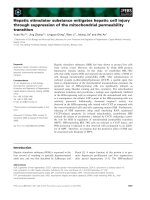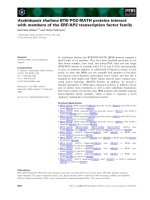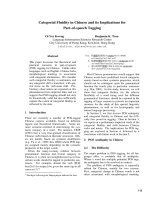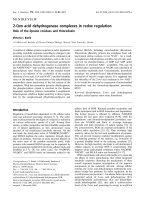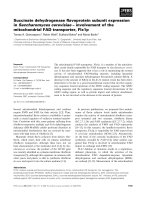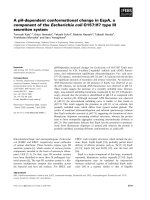Báo cáo khoa học: "Ethics review: ‘Living wills’ and intensive care – an overview of the American experience" docx
Bạn đang xem bản rút gọn của tài liệu. Xem và tải ngay bản đầy đủ của tài liệu tại đây (50.92 KB, 5 trang )
Page 1 of 5
(page number not for citation purposes)
Available online />Abstract
Withdrawal and limitation of life support in the intensive care unit is
common, although how this decision is reached can be varied and
arbitrary. Inevitably, the patient is unable to participate in this
discussion because their capacity is limited by the nature of the
illness and the effects of its treatment. Physicians often discuss
these decisions with relatives in an attempt to respect the patient’s
wishes despite evidence suggesting that the relatives may not
correctly reflect the patient’s desires. Advance decisions,
commonly known as ‘living wills’, have been proposed as a way of
facilitating the maintenance of an individual’s autonomy when they
become incapacitated. Others have argued that legalising advance
decisions is euthanasia by the back door. In October 2007 in
England and Wales, advance decisions will become legally binding
as part of the 2005 Mental Capacity Act. This has been the case in
the USA for many years. The purpose of the present review is to
examine the published literature regarding the effect of advance
decisions in relation to the provision of adult critical care.
Introduction
Autonomy, competence and capacity are limited by the
nature of the critical illness, or by the effects of treatment.
Withdrawing life-support in the intensive care unit (ICU) is
common and is often made without the direct involvement of
the patient, whose preferences regarding end-of-life
treatment are usually unknown [1,2]. Physicians therefore
frequently consult relatives regarding the appropriateness of
treatment intervention, despite data suggesting that the
consulted relatives find this emotionally stressful and do not
consistently make decisions that accurately reflect their
relative’s wishes [3,4].
Advance decisions (ADs), commonly known as ‘living wills’,
have been proposed as a way of facilitating the maintenance
of a patient’s autonomy if they become incapacitated in the
future. In October 2007 in England and Wales, ADs will
become legally binding as part of the 2005 Mental Capacity
Act. This has been the case in the USA for over 20 years [5].
The 2005 Mental Capacity Act allows a competent person
aged over 18 to make an AD that pre-emptively states their
treatment preferences or to appoint a lasting power of
attorney (LPA) to make decisions for them, if they become
incapacitated. There is no set format for an AD (it can be
written or verbal) unless it is specifically pertaining to refusing
life-sustaining treatment, where it must be written and
counter-signed. There is no obligation to seek advice from
medical professionals when drawing up an AD, and it can be
revoked verbally. If valid to the clinical scenario, an AD will
override a LPA if one exists. The LPA must act in the patient’s
best interests, must be registered with the Office of Public
Guardian, and the document must be structured in a statutory
form that is counter-signed by an independent third party. The
LPA can refuse life-sustaining treatment if it is explicitly stated
in the patient’s draft, is counter-signed and is deemed to be
compatible with the patient’s ‘best interests’. Where
disagreement exists between the attending physicians and
either the AD or the LPA regarding their validity to the clinical
situation, the Court of Protection can arbitrate [6]. Complying
with the patient’s preferences will in part depend on the
difficult ‘diagnosis’ of futility and the relevance of the clinical
scenario to the AD.
The purpose of the present review is to examine the effects
ADs have had for critically ill adults. A MedLine and PubMed
search was performed using the search terms ‘intensive
care’, ‘advance decisions’, living wills’ and ‘surrogates’.
Appropriate referenced articles were also included. The bulk
of the reviewed literature pertaining to ADs has come from
American studies unless specifically stated.
Quality-of-life judgements and advance
decisions
The decision to limit therapy in the ICU can be varied
depending on the beliefs and local practice variations of the
Review
Ethics review: ‘Living wills’ and intensive care – an overview of
the American experience
Andrew RJ Tillyard
Specialist Registrar, Intensive Care Department, Royal Cornwall Hospital, Truro TR1 5LJ, UK
Corresponding author: Andrew RJ Tillyard,
Published: 11 July 2007 Critical Care 2007, 11:219 (doi:10.1186/cc5945)
This article is online at />© 2007 BioMed Central Ltd
AD = advance decision; ICU = intensive care unit; LPA = lasting power of attorney; QOL = quality of life.
Page 2 of 5
(page number not for citation purposes)
Critical Care Vol 11 No 4 Tillyard
attending intensivists [7]. Withdrawal is often based on futility
or on the perceived prospect that if the patient did survive, it
would be with a significantly reduced quality of life (QOL)
[1,7]. Determining futility is heavily dependent on determining
the outcome, but the likelihood of general nonsurvivability
from a critical illness is not an objective or precise tool [8].
There is no perfect measure of QOL [9], and neither is there
a correlation between the severity of illness and the health-
related QOL at 6 months: the QOL is not predictable from
the clinical information at the time of the acute illness [10].
Finally, despite a reduced functional ability after discharge,
the majority of survivors were happy with their QOL and
would undergo intensive care again, especially the elderly
[10-17]. Establishing the appropriateness of ongoing ICU
care based in part on issues such as the resulting QOL may
therefore become more similar to the patient’s wishes if they
have given their reasons for refusing certain medical
interventions.
Unfortunately, there is very little clinical evidence to suggest
that ADs improve decision-making. One study of patients and
doctors given clinical scenarios with and without the
presence of an AD suggested that ADs made the physician’s
decision more compatible with that of the patient [18]. The
SUPPORT study of 9,105 seriously ill patients, however,
found the AD was associated only with insignificant trends
towards improvement in the provision of resuscitation [19]. In
the same study, 60% of surrogates stated that the AD helped
only a little or not at all for patients who had an AD and died.
These findings may be influenced by the fact that, of the
patients with an AD, only 12% completed it with physician
involvement, and only 25% of physicians were aware that the
patient had an AD. There is also no requirement for the
individual to state their reasons for refusing a medical
intervention, which may explain why ADs have been shown to
increase conflict between family members and attending
physicians [20]. This conflict can be related to the different
interpretations that different relatives and physicians have of
the patient’s AD and the progress and prognosis of the acute
illness. Finally, relatives cannot be relied upon to introduce
the AD at the onset of a critical illness: sometimes they have
used the AD to initiate less invasive support early on and
sometimes the AD has not been made known at all [21].
Cost of intensive care provision and advance
decisions
Intensive care is an expensive and limited resource,
consuming up to 20% of the entire hospital budget and 1%
of the nation’s gross domestic product [22]. Overall, 25% of
patients that require intensive care die while in the ICU [23].
This is in part due to the aging population, because intensive
care is being offered to an older and more unwell group of
patients [24]. Patients aged over 65 account for 64.9% of all
cases of sepsis and for greater than 50% of the ICU bed
occupancy [25,26]. The World Bank population statistics
have shown that the over-65 age group has increased
dramatically while the proportion of the older population who
remain employed has reduced [27]. In America, the number
of patients aged over 85 has increased by 38% from 1990 to
2000 [28].
If elderly patients with a potential critical illness are
questioned about end-of-life decisions, up to 41% choose to
limit certain life-sustaining therapies including cardiopulmonary
resuscitation, ventilation and ICU admission [29,30]. Poten-
tially because of this, the majority of studies analysing the
financial effect of ADs have shown reduced expenditure [31].
In one study, the average cost of end-of-life care in a
university hospital was reduced from $95,000 to $30,000
[32]. These savings were due to shorter durations of ICU stay
and hospital stay rather than due to patients with ADs being
provided less ICU therapies [33]. Indeed, these patients
received the same number or more interventions than those
patients without an AD [2,33-36]. One interpretation of this
observation is that patients with an AD are receiving full and
active treatment but, once it becomes ‘futile’, treatment is
stopped more quickly out of respect for the patient’s wishes.
Anecdotally, it is easier to withdraw treatment when the family
and staff are in agreement that this is what the patient would
have wanted.
Incidence of advance decisions in the
intensive care unit
ADs have existed in the USA for more than 20 years but the
number of people who actually have a written AD remains
small [5]. The number of ADs in patients with unanticipated
critical illness is especially limited, with only 5–11% of
patients having an AD [34,37-39]. In a separate American
study of patients with relapsed haematological malignancy,
the percentage of patients with an AD only rose to 32%
despite the patient having had more time than most people to
consider their own mortality and the possibility of requiring
critical care [33]. It can therefore be assumed that the
number of ADs in those patients with a sudden unexpected,
critical illness will be very limited in England and Wales for
many years past 2007.
How will the lasting power of attorney be
assessed?
The predetermined LPA or surrogate can make decisions on
an incompetent patient’s behalf that can include the ability to
refuse life-sustaining treatment if the document appointing
the LPA explicitly acknowledges this. Because the 2005
Mental Capacity Act is statutory law, it will become a criminal
offence to ignore the AD or the LPA. This leaves the potential
for the physician to be found guilty of the offence of ‘Battery’
if they do not comply.
The SUPPORT study and the HELP study of elderly and
acutely ill inpatients found that, of 1,041 patients who had
expressed a clear preference regarding resuscitation, more
than 70% said that if they did become incapacitated they
Page 3 of 5
(page number not for citation purposes)
would want the family and physician to make the resuscitation
decisions rather than having their own AD followed [40]. Yet
the level of agreement between the surrogate’s decision and
the patient’s preference in real and hypothetical seriously ill
scenarios was only 68% in a meta-analysis of 16 studies
analysing this outcome [41]. To highlight this observation, in
an Australian study 83% of patients did not want invasive
treatment and 76% of the surrogates agreed invasive
treatment was inappropriate, but all surrogates initiated it
[42]. Finally, discussing the advance decision with the
surrogate and the patient does not improve the surrogate’s
accuracy. In a study of 717 seriously ill patients and their
surrogates, 54% were assigned to the intervention group,
which included discussions regarding the prognosis,
treatment, resuscitation and ADs, but there was no significant
improvement in decision-making on reassessment [43].
These statistics lend weight to the value and importance
placed on a surrogate by the patient, but questions their
accuracy and detracts from the value of the AD in the first
place.
There are other significant practical problems regarding how
the LPA will be involved in the decision-making process in the
ICU. How much needs to be discussed and documented:
routine therapy such as fluids or only the more invasive
medical procedures? Secondly, the LPA is expected to make
decisions in the best interests of the patient. How will their
decision-making abilities and decisions be judged to be in the
best interests of the patient? In America, if there is doubt or
disagreement between staff and the LPA, a second opinion is
recommended, followed by an ethics consultation,
culminating with legal advice if still unresolved [44]. A similar
process including an Independent Mental Capacity Advisor
and the Court of Protection will occur in England and Wales.
Interpreting advance decisions in the
intensive care unit
The majority of ADs that have been encountered in the
intensive care setting are general in nature regarding the
limitation of treatment, rather than specific to a particular
critical illness [45,46]. The acutely ill patient in critical care
does not always have a specific diagnosis initially, which
leads to uncertainties regarding the appropriate treatment, its
probable efficacy and the prognosis. These factors will
combine to significantly increase the difficulty as regards
when the AD should be implemented, its true applicability to
the clinical situation and how it is interpreted.
Following an AD and withholding treatment may not always
appear to be in the person’s ‘best interests’. A patient’s AD,
however, needs only conform to their values rather than their
‘best medical interests’ – the Jehovah’s Witness being the
classic example. Ignoring the AD because it is thought the
reasoning behind it was poor is potentially risky:
‘professionals should start from the assumption that a person
who has made an AD had capacity to make it’ [6].
In a previous case bought before the English Courts in 1994,
irrational thought did not equal incompetence when refusing
treatment [47]. The case involved a schizophrenic man who
was refusing to have his gangrenous toe amputated because
he did not consider life without his toe acceptable. The
attending surgeons tried to argue that this was irrational, and
therefore the patient lacked competence, and were seeking
permission to proceed with the amputation. The courts ruled
in the patient’s favour, however, because he fulfilled the
requirements of competence: he had been given and retained
the information, he understood and believed the gravity of his
decision, and he evaluated the information in relation to his
self. It can be seen that a great concern with the AD is not
the AD itself, but that it becomes medico-legally easier to
follow the AD rather than to strive to keep the patient alive.
Suicide, intensive care and advance decisions
The 2005 Mental Capacity Act expressly rejects an AD that is
drawn up to facilitate suicide. A young person completing an
AD and subsequently taking a paracetamol overdose to
ensure active treatment is withheld is therefore not legally
binding: this would be euthanasia by omission because death
is the intended outcome and not providing treatment
facilitates this outcome.
For many people, however, there are situations where one’s
own life would not be deemed worthwhile because one’s
resultant QOL would fall below their own subjective threshold
of acceptability. Although made autonomously, it has been
said that to knowingly refuse certain treatment because of the
probable residual QOL, with the inevitable consequence
being death, is morally no different to the decision to actively
end one’s life because of one’s QOL [48]. It is argued that
this legalises euthanasia by the back door: ‘pre-emptive
euthanasia by omission’. The morally correct action of limiting
life-sustaining treatment depends on futility and burden.
Senior Catholic ethicists have gone as far as to state that
self-destructive choices do not necessarily warrant respect:
the choices made ‘have to be consistent with the
fundamental dignity of both the chooser and others’ [48]. The
counter argument to this is that, because death is not the
intended outcome, an AD is not euthanasia by omission: a
treatment that provides/maintains an acceptable QOL is
wanted, and if therapy cannot achieve this then it is refused.
Conclusion
The present review has shown that there is very little
evidence regarding the effect that ADs actually have on the
treatment of acutely ill patients in the ICU. The potential
benefit of an AD in the ICU includes that it will probably
reduce the cost of ICU care, and this will not be secondary to
a restriction of therapy offered. The review suggests the AD
will not invariably produce treatment that is consistent with
the patient’s wishes, however, and therefore it cannot be
assumed to always facilitate harmonious decision-making at
the end of life or to maintain an incapacitated patient’s
Available online />autonomy. The present review also highlights the problem of
how different people interpret and use an AD, and introduces
the difficulty of where an AD should be kept if relatives
cannot always be relied upon to make them available. A great
concern is that it may become easier to follow an AD that will
be very unlikely to result in legal action. It will be the far bolder
physician who is prepared to interpret and ignore an AD.
Competing interests
The author declares that they have no competing interests.
References
1. Wunsch H, Harrison DA, Harvey S, Rowan K: End-of-life deci-
sions: a cohort study of the withdrawal of all active treatment
in intensive care units in the United Kingdom. Intensive Care
Med 2005, 6:823-831.
2. Teno JM, Lynne J, Phillips RS, Murphy D, Youngner SJ, Bellamy P,
Connors AF, Desbiens NA, Fulkerson W, Knaus WA: Do formal
advance directives affect resuscitation decisions and the use
of resources for seriously ill patients? SUPPORT Investigators.
Study to Understand Prognoses and Preferences for Out-
comes and Risks of Treatments. J Clin Ethics 1994, 5:23-30.
3. Azoulay E, Pochard F, Kentish-Barnes N, and the FAMIREA Study
Group: Risk of post-traumatic stress symptoms in family
members of intensive care unit patients. Am J Respir Crit Care
Med 2005, 171:987-994.
4. Emmanuel EJ, Emmanuel LL: Proxy decision making for incom-
petent patients: an ethical and empirical analysis. JAMA 1992,
267:2067-2071.
5. Doukas D: Advance directives in patient care: if you ask, they
will tell you. Am Family Phys 1999, 59:530-533.
6. UK Department of Health: Mental Capacity Act 2005 Code of
Practice 2007 [www.opsi.gov.uk/acts/en2005/ukpgaen_20050009_
en_cop.pdf]
7. Predergast TJ, Claessens MT, Luce JM: A national survey of
end-of-life care for critically ill patients. Am J Respir Crit Care
Med 1998, 158:1163-1167.
8. Bernat JL: Medical futility. Definition, determination, and dis-
putes in critical care. Neurocrit Care 2005, 2:198-205.
9. Wu A: Long term outcomes in survivors from critical illness.
Anaesthesia 2004, 59:1049-1052.
10. Maynard SE, Whittle J, Chelluri L, Arnold R: Quality of life and
dialysis decisions in critically ill patients with acute renal
failure. Intensive Care Med 2003, 29:1589-1593.
11. Ridley S, Biggam M, Stone P: A cost–utility analysis of inten-
sive therapy. II: Quality of life in survivors. Anaesthesia 1994,
49:192-196.
12. Konopad E, Noseworthy TW, Johnstone R, Schustack A, Grace
M: Quality of life measures before and one year after admis-
sion to an intensive care unit. Crit Care Med 1995, 23:1653-
1659.
13. Danis M, Patrick DL, Southerland LI, Green ML: Patients’ and
families’ preferences for medical intensive care. JAMA 1988,
260:797–802.
14. Angus DC, Carlet J, and the 2002 Brussels Roundtable Partici-
pants: Surviving intensive care: a report from the 2002 Brus-
sels Roundtable. Intensive Care Med 2003, 29:368-377.
15. Montuclard L Garrouste-Orgeas M, Timsit JF, Misset B, De
Jonghe B, Carlet J: Outcome, functional autonomy, and quality
of life of elderly patients with a long-term intensive care unit
stay. Crit Care Med 2000, 28:3389-3395.
16. Chelluri L Im KA, Belle SH, Schulz R, Rotondi AJ, Donahoe MP,
Sirio CA, Mendelsohn AB, Pinsky MR: Long-term mortality and
quality of life after prolonged mechanical ventilation. Crit Care
Med 2004, 32:61-69.
17. Frick S, Uehlinger DE, Zuercher Zenklusen RM: Medical futility:
predicting outcome of intensive care unit patients by nurses
and doctors – a prospective comparitive study. Crit Care Med
2003, 31:456-461.
18. Coppola KM, Ditto PH, Danks JH, Smuker WD: Accuracy of
primary care and hospital-based physicians’ predictions of
elderly outpatients’ treatment preferences with and without
advance directives. Arch Internal Med 2001, 161:431-440.
19. Teno J, Lynn J, Wenger N, Phillips RS, Murphy DP, Connors AF,
Desbiens N, Fulkerson W, Bellamy P, Knaus W, for the
SUPPORT Investigators: Advance directives for the seriously ill
hospitalised patients: effectiveness with the patient self-
determination act and the SUPPORT intervention. J Am Geriatr
Soc 1997, 45:500-507.
20. Ewer MS, Taubet JK: Advance directives in the intensive care
unit of a tertiary cancer centre. Cancer 1995, 76:1268-1274.
21. Kavic SM, Atweh N, Possenti PP, Ivy ME: The role of advance
directives and family in end-of-life decisions in critical care
units. Conn Med 2003, 67:531-534.
22. Polderman KH, Metnitz PGH: Using risk adjustment systems in
the ICU: avoid scoring an ‘own goal’. Intensive Care Med 2005,
31:1471-1473.
23. Audit Commission: Critical to Success. London; 1999 [http://
www.audit-commission.gov.uk/Products/NATIONAL-REPORT/
40B50F26-ED9F-4317-A056-042B31AEA454/
CriticalToSuccess.pdf].
24. McCarthy JT: Prognosis of patients with acute renal failure in
the intensive-care unit: a tale of two eras. Mayo Clin Proc
1996, 71:117-126.
25. Martin GS, Mannino DM, Moss M: The effect of age on the
development and outcome of sepsis. Crit Care Med 2006, 34:
15–21.
26. Angus DC, Kelley MA, Schmitz RJ, White A, Popovich J, Commit-
tee on manpower for pulmonary and critical care societies (COM-
PACCS): Caring for the critically ill patient. Current and
projected workforce requirements for care of the critically ill
and patients with pulmonary disease: can we meet the
requirements of an aging population? JAMA 2000, 284:2762-
2770.
27. National Statistics Online [ />nugget.asp?id=949]
28. Hetzel L, Smith A: The 65 years and over population: 2000.
Census 2000 brief [ />c2kbr01-10.pdf]
29. Reilly BM, Magnussen CR, Ross J, Ash J, Papa L, Wagner M: Can
we talk? Inpatient discussions about advance directives in a
community hospital. Attending physicians’ attitudes, their
inpatients’ wishes, and reported experience. Arch Internal Med
1994, 154:2299-2308.
30. Essebag V, Cantarovich M, Crelinsten G: Routine advance
directive and organ donation questioning on admission to
hospital. Ann R Coll Phys Surg Canada 2002, 35:225-231.
31. Weeks WB, Kofoed LL, Wallace AE, Welch HG: Advance direc-
tives and the cost of terminal hospitalization. Arch Internal
Med 1994, 154:2077-2083.
32. Chambers CV, Diamond JJ, Perkel RL, Lasch LA: Relationship of
advance directives to hospital charges in a Medicare popula-
tion. Arch Internal Med 1994, 154:541-547.
33. Kish Wallace S, Martin CG, Shaw AD, Price KJ: Influence of an
advance directive on the initiation of life support technology
in critically ill cancer patients. Crit Care Med 2001, 29:2294-
2298.
34. Goodman MD, Tarnoff M, Slotman GJ: Effect of advance direc-
tives on the management of elderly critically ill patients. Crit
Care Med 1998, 26:701-704.
35. Danis M, Southerland LI, Garrett JM, Smith JL, Hielema F, Pickard
CG, Egner DM, Patrick DL: A prospective study of advance
directives for life-sustaining care. N Engl J Med 1991, 324:
882-888.
36. Schneiderman LJ, Kronick R, Kaplan RN, Anderson JP, Langer
RD: Effects of offering advance directives on medical treat-
ments and costs. Ann Internal Med 1992, 117:599-606.
37. Faber-Langendoen K: A multi-institutional study of care given
to patients dying in hospitals. Ethical and practice implica-
tions. Arch Internal Med 1996, 156:2130-2136.
38. Karlawish JH, Hall JB: Managing death and dying in the inten-
sive care unit. Am J Respir Crit Care Med 1997, 155:1-2.
39. Johnson RF, Baranowski-Birkmeier T, O’Donnell JB: Advance
directives in the medical intensive care unit of a community
teaching hospital. Chest 1995, 107:752-756.
40. Puchalski C, Zhong Z, Jacobs MM, Fox E, Lynne J, Harrold J,
Galanos A, Phillips RS, Califf R, Teno JM: Patients who want
their family and physician to make resuscitation decisions for
them: observations from SUPPORT and HELP. J Am Geriatr
Soc 2000, 48:S84-S90.
Critical Care Vol 11 No 4 Tillyard
Page 4 of 5
(page number not for citation purposes)
41. Shalowitz DI, Garrett-Meyer E, Wendler D: The accuracy of sur-
rogate decision makers. A systematic review. Arch Internal
Med 2006, 166:493-497.
42. Corke CF, Lavery JF, Gibson AM: Choosing life support for sud-
denly severely ill relatives. Crit Care Resusc 2005, 7:81-86.
43. Marbella AM, Desbiens NA, Mueller-Rizner N, Layde PM: Surro-
gates’ agreement with patients’ resuscitation preferences:
effect of age, relationship, and SUPPORT intervention. J Crit
Care 1998, 13:140-145.
44. Bramstedt KA: Questioning the decision-making capacity of
surrogates. Internal Med J 2003, 33:257-259.
45. Block AJ: Living wills are overrated. Chest 1993, 104:1645-
1646.
46. Emmanuel LL: Does the DNR order need life-sustaining inter-
vention? Time for comprehensive advance directives. Am J
Med 1989, 86:87-90.
47. Re C (Adult: Refusal of Medical Treatment) [1994] All ER 819
48. Gormally L: Legislating for advance refusals of treatment: what
is at issue? [ />Available online />Page 5 of 5
(page number not for citation purposes)
